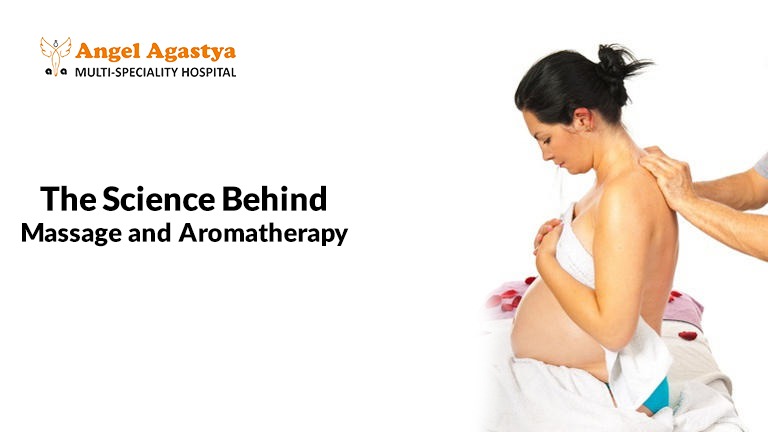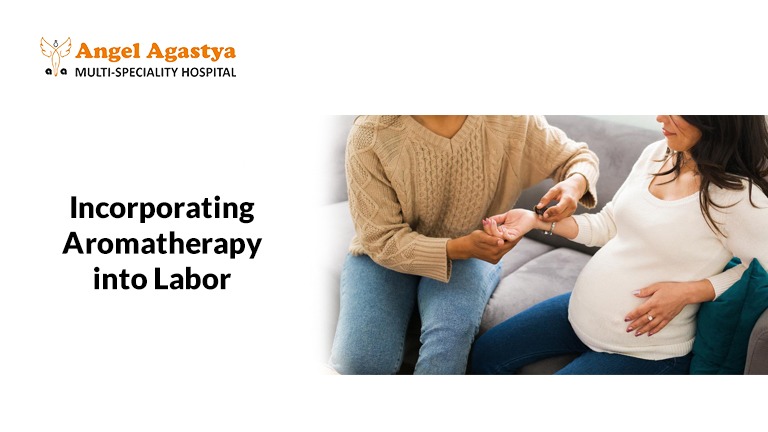Roles of Massage and Aromatherapy in Achieving a Painless Normal Delivery
Discover how massage and aromatherapy can transform your childbirth experience by reducing pain, easing tension, and promoting relaxation. Learn the proven techniques that support a smoother, more comfortable normal delivery.
Introduction
Life’s most profound and transformative experiences, bringing a mix of emotions is Painless normal delivery —joy, excitement, anxiety, and apprehension. The physical demands of labor, combined with emotional fluctuations, make it a unique journey for every woman. While childbirth is a natural physiological process, the pain associated with labor can be challenging. Over time, many women have sought natural, non-invasive methods to make this journey less stressful and more empowering. Massage and aromatherapy have emerged as two effective complementary therapies that can significantly reduce pain, alleviate anxiety, and foster relaxation during labor.
These holistic approaches have been gaining recognition for their ability to enhance the childbirth experience without the side effects often associated with medical pain relief methods. This blog explores the science behind massage and aromatherapy, the techniques involved, and their transformative role in promoting a painless normal delivery.
The Science Behind Massage and Aromatherapy
To understand the effectiveness of massage and aromatherapy, it is essential to delve into the physiological and psychological mechanisms they influence during labor.

Massage Therapy
Massage therapy is more than just a physical intervention. It works by impacting the body’s hormonal and nervous systems, contributing to both pain relief and emotional well-being.
- Release of Endorphins: Massage stimulates the release of endorphins, the body’s natural painkillers. These hormones bind to opioid receptors in the brain, creating a sense of euphoria and reducing the perception of pain.
- Relaxation of Muscles: Labor often causes tension in the back, shoulders, and pelvic area. Gentle manipulation of soft tissues through massage helps relax these muscles, making labor more comfortable.
- Improved Blood Circulation: Increased circulation facilitates better oxygen delivery to the uterus and other tissues, promoting efficient contractions and reducing fatigue.
- Reduction in Stress Hormones: Massage helps lower cortisol and adrenaline levels, thereby reducing anxiety and stress.
Aromatherapy
Aromatherapy, which utilizes essential oils extracted from plants, has been a cornerstone of traditional medicine for centuries. Its calming and therapeutic effects are particularly beneficial during labor.
- Impact on the Limbic System: When inhaled, essential oil molecules stimulate the olfactory receptors, sending signals to the limbic system in the brain. This part of the brain governs emotions, stress levels, and hormonal balance, making it a powerful target for relaxation.
- Anxiolytic Properties: Essential oils like lavender and chamomile are known for their ability to calm the mind and reduce anxiety, helping women manage labor more effectively.
- Pain Relief: Certain oils, such as clary sage, possess mild analgesic properties and can help reduce the intensity of contractions.
- Uterine Stimulation: Clary sage and jasmine oils are believed to enhance uterine contractions, promoting the progress of labor while minimizing discomfort.
Massage Techniques for Painless Normal Delivery

For many women, the idea of a painless normal delivery might seem out of reach, but with the right techniques, it is possible to reduce discomfort significantly during labor and delivery. Massage techniques tailored to the needs of laboring mothers can be an excellent way to manage pain, reduce stress, and create a more positive childbirth experience. These methods not only offer physical relief but also provide emotional support, helping the mother stay calm and confident throughout the process.
Here are some widely used massage techniques that promote a painless normal delivery:
Effleurage: Gentle Strokes for Relaxation

Effleurage is a technique that involves light, rhythmic strokes on the abdomen, back, or thighs. It is especially effective during the early stages of labor when contractions are mild but still noticeable. This gentle, soothing motion distracts the brain from focusing on the pain, fostering relaxation and a sense of control. Mothers can perform this technique themselves or have their birthing partner assist.
The strokes in effleurage are not just about touch—they create a calming rhythm that syncs with your breathing, allowing you to remain relaxed and focused. Many women find this technique helpful in maintaining their energy and reducing anxiety during the initial hours of labor. When combined with deep breathing exercises, effleurage becomes a powerful tool for pain management during labor, guiding you closer to the goal of a painless normal delivery.
Counter-Pressure: Relief for Back Labor

Back labor, which occurs when the baby is in a posterior position, can cause intense discomfort in the lower back. Counter-pressure is a massage technique designed specifically to alleviate this pain. It involves applying firm, steady pressure to certain points on the back, hips, or sacrum using hands, knuckles, or even tools like a tennis ball.
The beauty of counter-pressure lies in its ability to relieve the intense sensations caused by contractions. Your birthing partner or doula can use this technique by pressing into your lower back or sacral area during a contraction. This pressure counteracts the discomfort caused by the baby’s position, making the process more bearable.
This method is not only effective but also empowers partners to take an active role in supporting the mother, creating a strong sense of teamwork and emotional bonding during labor.
Acupressure: Traditional Wisdom for Modern Births
Acupressure, rooted in traditional Chinese medicine, involves applying firm pressure to specific points on the body to relieve pain and promote progress in labor. This technique is a natural and safe way to manage discomfort and enhance the body’s natural ability to deliver the baby.

Some commonly used acupressure points include:
- BL32 (Lower Back): Located near the sacrum, this point helps relieve back pain and can even strengthen contractions.
- SP6 (Inner Ankle): Stimulating this point can promote uterine contractions and provide overall relaxation.
- LI4 (Hand): Found in the webbing between your thumb and index finger, this point is excellent for relieving stress and encouraging contractions.
Acupressure is a practical and non-invasive way to support a painless normal delivery. However, it’s best to learn these techniques under the guidance of a trained professional before labor begins.
Kneading and Circular Motions: Releasing Tension
Another effective massage technique involves kneading the muscles in areas like the shoulders, lower back, and thighs. Labor often brings tension and fatigue to these regions, which can amplify discomfort if left unaddressed. Kneading the muscles helps loosen them, encouraging relaxation and reducing pain.

Circular motions on the lower back can also alleviate pressure caused by contractions. These gentle movements stimulate blood flow, ease muscle tightness, and provide comfort, especially during the active phase of labor.
Additionally, combining these massage techniques with warm compresses or essential oils can enhance their effectiveness, creating a soothing and nurturing environment that supports natural childbirth.
Benefits of Massage for a Painless Normal Delivery
Massage techniques not only reduce physical pain but also help mothers maintain a positive mindset. They are particularly effective when combined with other relaxation techniques for labor, such as breathing exercises, meditation, and visualization. These approaches work together to minimize fear and tension, which are often the root causes of heightened pain during labor.

Furthermore, massages stimulate the release of endorphins—your body’s natural painkillers. These hormones reduce the perception of pain and promote feelings of well-being, making it easier to achieve a painless normal delivery.
Empower Yourself with the Right Support
While these techniques are highly effective, the key to success lies in preparation and practice. Attend childbirth classes, learn these methods with your partner or caregiver, and create a birth plan that prioritizes your comfort and well-being.

By using these massage techniques alongside other methods for pain management during delivery, you can take a significant step toward a natural, positive, and as pain-free as possible childbirth experience. A painless normal delivery isn’t just a dream—it’s achievable with the right knowledge and support.
Incorporating Aromatherapy into Labor
Aromatherapy can be seamlessly integrated into labor care, either on its own or in conjunction with massage therapy. The right essential oils can create a calming and supportive environment, enhancing the overall birth experience.

Inhalation Techniques
- Aromatherapy Diffusers: Diffusers disperse essential oils into the air, creating a soothing atmosphere in the labor room.
- Direct Inhalation: A few drops of essential oil can be applied to a cotton ball or tissue for the mother to inhale during contractions.
- Steam Inhalation: Adding essential oils to hot water and inhaling the steam can have both calming and decongestant effects.
Massage with Essential Oils
Combining essential oils with massage enhances the therapeutic experience. For safety, oils must be diluted with carrier oils like coconut, almond, or jojoba oil.
Top Essential Oils for Labor
- Lavender: Renowned for its calming properties, lavender oil helps reduce stress, promote sleep, and ease muscle tension.
- Clary Sage: This oil is often used to enhance contractions and manage pain. It should only be used after labor begins, as it may stimulate uterine activity.
- Chamomile: Chamomile oil provides a calming effect, helping to reduce anxiety and improve focus during labor.
- Peppermint: Useful for relieving nausea, which is common during labor.
- Rose Oil: Known for its uplifting and stress-relieving properties, rose oil can create a nurturing environment during childbirth.
Precautions and Safety Guidelines
While massage and aromatherapy are generally safe, certain precautions must be observed to ensure their effectiveness and avoid potential risks.

Safety Considerations for Aromatherapy
- Use only high-quality, therapeutic-grade essential oils.
- Avoid oils that are contraindicated during pregnancy, such as rosemary or cinnamon.
- Dilute essential oils appropriately (1-2 drops per tablespoon of carrier oil).
- Conduct a patch test to check for skin sensitivities.
Working with Trained Professionals
Both massage and aromatherapy should ideally be performed by trained practitioners who specialize in prenatal and perinatal care. This ensures the techniques and oils used are safe and effective for laboring women.
The Role of Doulas and Support Persons
Doulas and support persons play a critical role in incorporating massage and aromatherapy into labor care.
How Doulas Help
- Massage Techniques: Doulas are trained to perform various massage techniques to ease pain and promote relaxation.
- Aromatherapy Expertise: They can recommend appropriate essential oils and guide their use during labor.
- Emotional Support: A doula’s calming presence can reduce stress and create a positive birthing environment.
Support persons, such as partners or family members, can also learn basic massage techniques to provide comfort during labor.
Benefits of Massage and Aromatherapy During Labor
The combined use of massage and aromatherapy offers numerous benefits:
- Reduced Pain: Both therapies can reduce the intensity of contractions and overall labor pain.
- Enhanced Relaxation: Aromatherapy creates a calming environment, while massage soothes tense muscles.
- Shortened Labor: Certain techniques and essential oils can stimulate efficient contractions, potentially reducing the duration of labor.
- Improved Emotional Well-Being: Women often feel more in control and empowered when these natural therapies are integrated into their birth plan.
Conclusion
Massage and aromatherapy are powerful allies in the pursuit of a painless normal delivery. These natural, non-invasive therapies not only address physical pain but also foster emotional resilience, making childbirth a more positive and empowering experience.
By reducing stress, enhancing relaxation, and promoting a sense of well-being, massage and aromatherapy can transform the birthing journey into a memorable and joyful event. Whether through the gentle touch of a massage or the calming aroma of lavender, these therapies provide women with tools to embrace labor with confidence and grace.
For expectant mothers looking to explore these therapies, working with experienced professionals and carefully choosing safe practices is essential. As more women turn to holistic approaches for labor, the use of massage and aromatherapy is set to redefine the childbirth experience—helping mothers feel nurtured, supported, and in control every step of the way.
FAQs
What are the best essential oils to use during labor?
Essential oils like lavender, clary sage, and chamomile are commonly used during labor. Lavender helps relax your mind and body, clary sage can support contractions, and chamomile calms nerves. Always dilute them with a carrier oil like coconut or almond oil before use.
Are there any contraindications for using aromatherapy during labor?
Yes, certain essential oils like rosemary, thyme, and cinnamon should be avoided as they may overstimulate or cause discomfort. Always consult a healthcare professional before using any essential oil, especially if you have a high-risk pregnancy.
How can I learn massage techniques for labor support?
You can learn through prenatal classes, online tutorials, or by consulting a trained doula or midwife. Techniques like counter-pressure, circular back massage, and foot massage are simple but effective for reducing labor pain.
Can I use aromatherapy at home during pregnancy to prepare for labor?
Yes, aromatherapy can help you relax and prepare your body for labor. Using lavender or ylang-ylang in a diffuser or adding a few drops to a warm bath can create a calming effect.
What is the role of my partner in incorporating massage and aromatherapy during labor?
Your partner can play a big role by giving gentle massages, applying pressure to your lower back, or using essential oils to help you relax. Their emotional support and physical presence are also key to easing your stress.
How can I find a doula who is trained in massage and aromatherapy?
Look for certified doulas in your area through online directories, hospitals, or recommendations from other mothers. Many doulas specialize in pain management techniques like massage and aromatherapy.
Are there any risks associated with using essential oils during pregnancy and labor?
Using the wrong essential oils, or using them undiluted, can cause irritation or harm. Always use pregnancy-safe oils in small quantities and consult a professional for guidance.
How can I discuss the use of massage and aromatherapy with my healthcare provider?
Bring it up during your prenatal appointments. Share the oils or techniques you want to use and ask for their advice or approval to ensure safety during labor.
What other natural methods can I use to manage pain during labor?
Breathing exercises, warm water baths, meditation, hypnobirthing, and moving around during labor are effective natural methods. Combining these with massage and aromatherapy can make labor more comfortable.
How can I create a relaxing and supportive environment for labor at home?
Use dim lighting, soft music, comfortable pillows, and calming essential oils in a diffuser. Have your partner or support person nearby for massages and emotional support to make you feel at ease.
These methods can help you work toward a painless normal delivery by reducing stress and promoting relaxation naturally.

